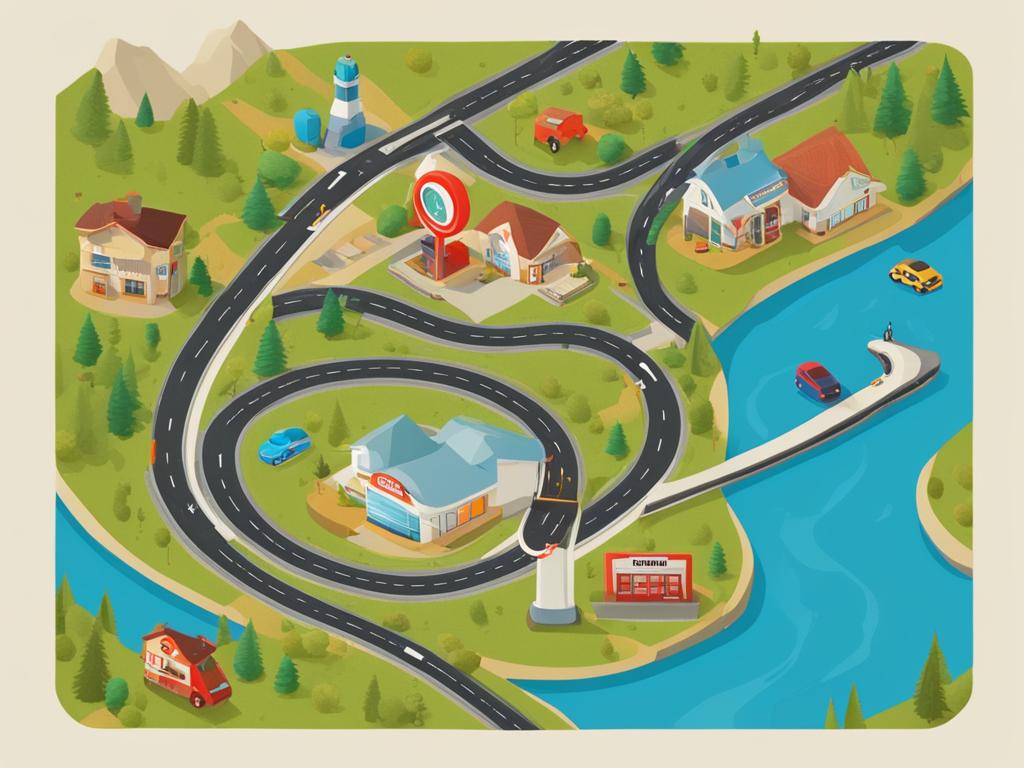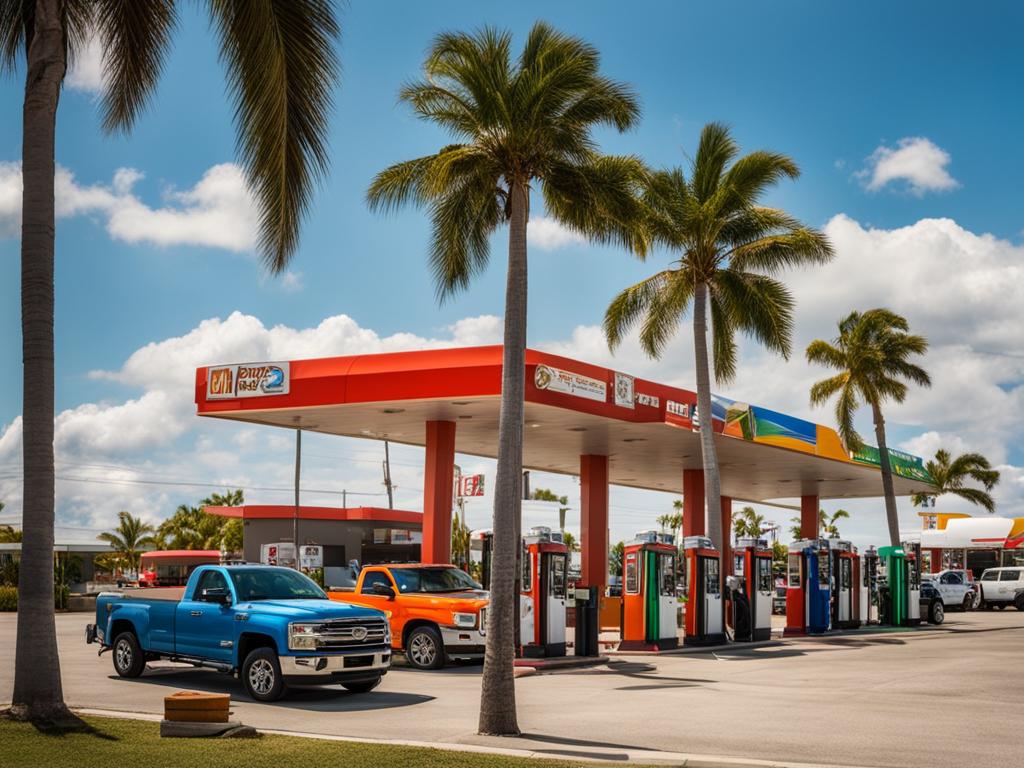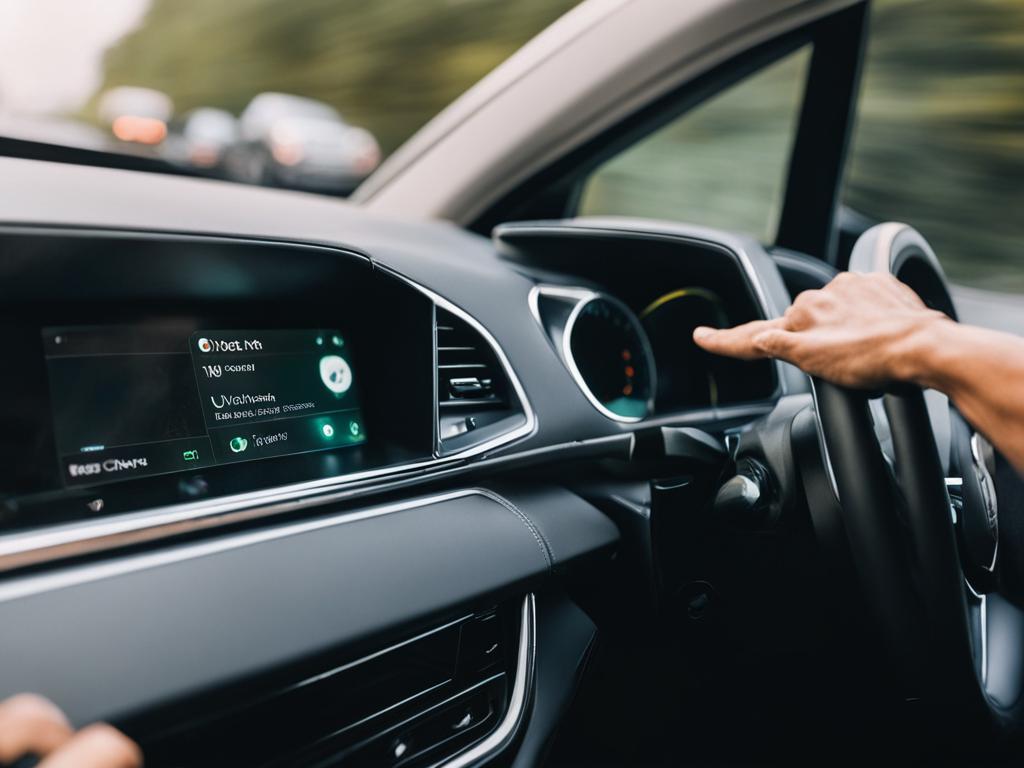Car Riders Guide: Tips for Safety & Comfort
Getting in a car and hitting the road can be an exciting adventure, whether you’re carpooling, ride-sharing, or using carpool services and apps. However, it’s crucial to prioritize safety and comfort to ensure a smooth journey. By following these tips, you can make your car ride a pleasant and secure experience.
Key Takeaways:
- Proper planning and preparation are essential for road trip safety.
- Rest adequately before embarking on a long-distance drive to prevent fatigue.
- Map out your route and have navigation tools, such as a paper map or GPS, to avoid getting lost.
- Adjust your seat and mirrors for optimal comfort and visibility.
- Use cruise control wisely to maintain a consistent speed and enhance fuel efficiency.
Importance of Rest and Preparation for Long-Distance Drives
Before embarking on a long-distance drive, it is crucial to prioritize rest and preparation. Driving for extended periods can be fatiguing, leading to increased risks on the road. Proper rest, adequate preparation, and strategic planning can help ensure safer and more enjoyable journeys.
Long-distance drives present unique challenges, including adverse road conditions and the potential for monotony. Fatigue can impair decision-making abilities and reaction times, increasing the likelihood of accidents. Taking the time to rest adequately before a long drive is essential for maintaining alertness and attentiveness behind the wheel.
Preparing for a long-distance drive involves multiple aspects. Firstly, ensure that your vehicle is in good condition, with all necessary maintenance and repairs completed. Check tire pressure, fluid levels, brakes, lights, and signals to minimize the risk of unexpected breakdowns or malfunctions. Equip your vehicle with an emergency kit, including a spare tire, necessary tools, and essential supplies.
Aside from vehicle preparation, it’s crucial to plan your route before hitting the road. Familiarize yourself with the path you will be taking, identifying potential rest stops, fuel stations, and accommodations along the way. This planning helps you anticipate and avoid long stretches without services, reducing the risk of running out of fuel or becoming stranded.
Resting and preparation also involve mental readiness. It’s essential to get a good night’s sleep before the journey, ensuring you are mentally and physically prepared for the long drive ahead. During the trip, plan breaks at regular intervals to stretch, hydrate, and rejuvenate yourself. These short breaks not only combat fatigue but also provide opportunities to appreciate the journey and stay engaged with your surroundings.
Rest and preparation for long-distance drives: Key takeaways
- Rest sufficiently before a long-distance drive to combat fatigue and improve alertness.
- Prepare your vehicle by ensuring it is in good condition and equipped with an emergency kit.
- Plan your route, identifying crucial rest stops, fuel stations, and accommodations.
- Get a good night’s sleep before the trip and take regular breaks during the drive to stay refreshed.
https://www.youtube.com/watch?v=75iLoRGP8xE
Mapping Your Route and Using Navigation Tools
When embarking on a road trip, mapping out your route is crucial to avoid getting lost along the way. While navigation tools like GPS offer convenience, it’s always a good idea to have a reliable paper map as a backup in case of technological failures. By familiarizing yourself with map-reading skills, you can navigate effectively and confidently during your journey.
In an age where digital technology dominates, the humble paper map still has its merits. Not only does it provide a tangible backup when GPS or mobile data isn’t available, but it also engages your spatial awareness and helps you visualize your journey. Before setting off, mark the key waypoints and intersections on your paper map, enabling you to have an overview of the entire route.
To optimize your use of navigation tools and paper maps, consider the following tips:
- Plan your route in advance: Take time to study your intended route, noting major landmarks, highway exits, and alternate routes. This preparation allows you to have a mental roadmap and adapt to changes easily.
- Use GPS for real-time updates: Utilize GPS navigation tools to enjoy turn-by-turn directions, traffic updates, and estimated arrival times. Be sure to keep your device charged and have a car charger handy.
- Have a compass on hand: While GPS is reliable, having a compass can provide additional assurance and assist with map orientation.
- Stay aware of your surroundings: Keep an eye out for prominent landmarks or signs that align with your route on both your navigation device and paper map. By cross-referencing, you can confirm you’re on the right track.

Adjusting Your Seat and Mirrors for Comfort and Safety
When embarking on a long drive, taking the time to properly adjust your seat and mirrors is essential for both comfort and safety. Finding the right seating position not only ensures optimal comfort but also allows for better visibility, reducing the risk of blind spots. By implementing these adjustments, you can greatly enhance your driving experience and promote safer navigation on the road.
First and foremost, focus on adjusting your seat to achieve a comfortable driving position. Start by positioning yourself with your back against the seatback, ensuring good support for your lower back. Adjust the seat height so that you have a clear view of the road and can comfortably reach the pedals with a slight bend in your knees. Additionally, adjust the seat angle to prevent excess pressure on your thighs and to maintain a relaxed posture.
Next, let’s address the mirror adjustments. Properly adjusted mirrors are crucial for maintaining situational awareness while driving. Your side mirrors should be positioned to minimize blind spots and provide a wider field of view. Position them so that you can see a small part of the side of your car and the rest of the view is the road behind you. The rearview mirror should provide a clear view of what’s happening directly behind you.
To ensure optimal visibility and eliminate blind spots, use the following technique:
- Adjust your left side mirror: Lean your head towards the left window, and adjust the mirror until you can see the edge of your car.
- Adjust your rearview mirror: Sit back in your normal driving position and adjust the mirror to provide a clear view of the road behind you.
- Adjust your right-side mirror: Lean your head towards the center of the car and adjust the mirror until you can see the edge of your car.
Remember, these mirror adjustments are just a starting point. Fine-tune them to suit your preferences and improve your field of view.
By making these seat and mirror adjustments, you can create a comfortable driving environment while ensuring better visibility and reducing the risk of blind spots. Don’t underestimate the importance of taking the time to adjust your seat and mirrors before embarking on a long drive—it can make a significant difference in both your comfort and safety on the road.
Strategic Use of Cruise Control
Utilizing cruise control can have several benefits, including maintaining a consistent speed, reducing driver fatigue, and promoting fuel efficiency. By engaging cruise control, drivers can set their desired speed limit, allowing for a more relaxed and comfortable driving experience.
One significant advantage of cruise control is its ability to minimize fluctuations in speed. It ensures that the vehicle maintains a steady pace, which can be especially useful on long stretches of highways and roads. By eliminating the need for constant acceleration and deceleration, cruise control helps reduce driver fatigue and increases overall comfort.
Moreover, the fuel efficiency gained from using cruise control should not be overlooked. By maintaining a consistent speed, the engine operates more efficiently, resulting in better fuel consumption. This can be particularly advantageous during long road trips, where every bit of savings on fuel counts.
However, it’s important to exercise caution and use cruise control wisely. While it can enhance driving comfort and fuel efficiency, drivers must remain attentive to changing road conditions, traffic, and weather. Always be prepared to disengage cruise control if necessary for safety reasons, such as when approaching sharp turns or hazardous weather conditions.
Remember, cruise control should be viewed as a helpful tool, not a substitute for active and responsible driving. Stay alert, maintain situational awareness, and adjust cruise control settings accordingly to ensure a safe and enjoyable journey.

Sharing Your Itinerary for Added Safety
When embarking on a road trip, it’s important to prioritize safety at all times. One proactive measure you can take to ensure a safer driving experience is to share your itinerary with a trusted friend or family member. By providing them with detailed information about your planned route, estimated departure and arrival times, and any planned stops along the way, someone will be aware of your whereabouts throughout your journey.
Sharing your itinerary serves multiple purposes, chief among them being safety. In the event of an emergency or unexpected delay, having someone aware of your planned stops and estimated timeline allows them to provide assistance or alert authorities if needed. It also brings peace of mind knowing that there is someone who can check in on you and ensure your well-being during the trip.
When sharing your itinerary, make sure to include emergency contact information as well. This way, your trusted contact can easily reach out to you or coordinate with emergency services if necessary.
Benefits of Sharing Your Itinerary:
- Enhanced safety and security
- Assistance in case of emergencies or unexpected events
- Peace of mind for both the traveler and their loved ones
Remember, safety should always be the top priority when embarking on a road trip. By sharing your itinerary and keeping someone informed about your planned route, estimated timings, and emergency contact details, you can enjoy your journey with added peace of mind.
Keep reading for more tips on how to make your road trip safer and more enjoyable!
Planning Fuel Stops Strategically
When embarking on a road trip, one of the key considerations is planning fuel stops strategically, especially when traveling through areas with long gaps between towns and limited gas stations. It’s important to ensure that you have enough fuel to reach the next town without the risk of becoming stranded in unfamiliar territory.
Before hitting the road, take the time to investigate opportunities to buy fuel along your planned route. Look for gas stations or fuel stops that align with your itinerary, allowing you to refuel and continue on your journey smoothly. By identifying these fuel stops in advance, you can avoid the stress of running out of gas and reduce the time spent searching for the nearest gas station.
While driving, pay attention to your fuel gauge and keep an eye out for road signs indicating the distance to the next gas station. This information can help you plan when and where to refuel, ensuring that you never find yourself stranded without a reliable fuel source.
For those traveling in diesel vehicles, it is even more crucial to plan fuel stops strategically. Diesel fuel may not be available at all gas stations, so knowing where to find diesel-friendly fuel stops is essential to keep your vehicle running smoothly throughout your journey.
By strategically planning your fuel stops and staying aware of your fuel levels, you can enjoy a stress-free road trip without worrying about running out of gas. Take the time to plan ahead and ensure that you have enough fuel to reach the next town, providing peace of mind and uninterrupted travel.

Importance of Obeying Speed Limits
When it comes to safe driving, obeying speed limits is a crucial aspect that should never be overlooked. Speed limits are in place to ensure the safety of all drivers on the road, as well as pedestrians and cyclists. It’s important to pay attention to speed limit signs and abide by them, even if there are no other cars around.
Speeding might seem harmless, especially if you think you can handle the increased speed. However, it significantly increases the risk of accidents and reduces the time you have to react to unexpected situations. It’s not worth risking your life, the lives of others, or the hefty fines and penalties associated with speeding tickets.
It’s essential to remember that missing a speed sign due to distractions or unfamiliarity with the area is not an excuse for speeding. As a responsible driver, it’s your duty to stay aware of the speed limits and adjust your driving accordingly.
By obeying speed limits, you contribute to a safer driving environment for everyone. It allows for better traffic flow, reduces the likelihood of collisions, and gives you more time to react to potential hazards. Safe driving is a responsibility that should never be taken lightly, and adhering to speed limits is a fundamental part of it.

The Dangers of Speeding
Exceeding the speed limit not only increases the likelihood of accidents but also magnifies their severity. According to the National Highway Traffic Safety Administration, speeding is a contributing factor in approximately one-third of all traffic fatalities in the United States–a statistic that underscores the dire consequences of disregarding speed limits.
| Adverse Effects of Speeding | Safe Driving Practices |
|---|---|
| ● Increased risk of accidents and collisions | ● Pay attention to and obey speed limit signs |
| ● Reduced time to react to unexpected situations | ● Adjust driving speed based on road conditions |
| ● Higher chance of severe injuries and fatalities | ● Keep a safe following distance |
| ● Exorbitant fines and penalties | ● Maintain a consistent and appropriate speed |
Always prioritize safe driving practices and make a conscious effort to avoid speeding. By doing so, you not only protect yourself and others but also contribute to creating a safer and more harmonious driving environment for everyone on the road.
Avoiding Distractions while Driving
When it comes to safe driving, avoiding distractions is of utmost importance. One of the most common distractions is the use of mobile phones and other gadgets while behind the wheel. Engaging with these devices diverts your attention from the road, increasing the risk of accidents.
To minimize distractions, it is recommended to set up your entertainment and navigation tools before you begin your journey. This includes adjusting volume levels, selecting music or podcasts, and setting your GPS or map to the desired destination. By doing so, you can reduce the need to interact with these devices while driving.
If you are traveling with children, it’s essential to properly supervise them to minimize distractions. Ensure they are occupied with activities such as coloring books, puzzles, or portable entertainment systems, keeping them engaged and allowing you to focus on the road.

Remember, your attention should always be on the road and surrounding traffic. By avoiding distractions, you can significantly improve your driving safety and the safety of others on the road.
Conclusion
Keeping road trip safety in mind is paramount for all car riders. By following these safe driving tips and prioritizing comfort, you can ensure a pleasant and secure journey. Remember to plan ahead, get enough rest before hitting the road, obey traffic laws, and stay alert throughout your trip. Safe travels are within your reach!
FAQ
Why is rest important before a long-distance drive?
Resting adequately before a long-distance drive helps prevent fatigue and ensures you are alert and focused on the road, promoting safer driving.
Why should I map out my route before starting a road trip?
Mapping out your route before a road trip helps you avoid getting lost and allows for better planning of fuel stops and rest breaks along the way.
How should I adjust my seat and mirrors for a comfortable and safe driving experience?
Adjust your seat and mirrors to ensure optimal comfort and visibility, eliminating blind spots and promoting safer navigation on the road.
What are the benefits of using cruise control during a long drive?
Cruise control helps maintain a consistent speed, reduces driver fatigue, and promotes better fuel efficiency, leading to a more comfortable and efficient driving experience.
Why should I share my itinerary with someone before a long trip?
Sharing your itinerary with a trusted friend or family member provides an additional safety measure as someone will be aware of your planned route and can check in on you if needed.
How can I plan fuel stops strategically during a long-distance drive?
Planning fuel stops in areas with long gaps between towns and limited gas stations can help avoid running out of gas. It is essential to be aware of the distance to the next gas station and ensure you have enough fuel to reach your destination.
Why is it important to obey speed limits while driving?
Obeying speed limits is crucial for the safety of all drivers on the road. Speed limits are in place to prevent accidents and promote safe driving practices.
How can I avoid distractions while driving?
Minimize distractions by avoiding phone use and setting up entertainment and navigation tools before you start your journey. If traveling with children, ensure they are properly supervised to allow you to focus on the road.
What is the significance of prioritizing safety and comfort on the road?
Prioritizing safety and comfort while on the road ensures a pleasant and secure journey. Following these road trip safety tips and implementing safe driving practices promote a safer and more enjoyable experience for all car riders.




